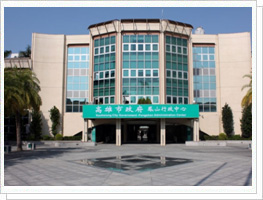| The Classical Beauty of Kaohsiung City Office |
 |
When you ride the convenient MRT system and approach the Love River that flows through the city center, a familiar Japanese building can be seen on the far bank amidst towering modern blocks. The building, designed by Japanese architect Yonejiro Ono, has a symmetrical Western classical exterior combined with traditional Japanese-style roof. It is currently the most well-preserved Japanese "Imperial Crown" style building in Taiwan. Now known as the "Museum of History", this was once Kaohsiung's second "City Office". |
| In 1924 the district and abolished and town was abolished. Under the new system, Kaohsiung Town became Kaohsiung City. A "City Office" was also set up reporting directly to the Kaohsiung State. The first "City Office" was located in Gushan District at what is Daitian Temple today. The second Kaohsiung City Office was built in 1938 (13th year of the Showa Era) and commissioned in September 16 of the following year. At the end of World War 2, the "City Office" was renamed the "Kaohsiung City Government" in 1945 and remained the city's administrative center until 1992. After the relocation of the city government, the decision was made to convert the historic City Office building into the Kaohsiung Municipal Museum of History. The new museum was opened in 1998 and is now playing a new role in the lives of Kaohsiung residents by preserving and promoting the history and culture of Kaohsiung. |
 |
| Kaohsiung City Government's Xiwei Administration Center |
 |
A fast-growing population and rapid industrial/commercial development meant that the Kaohsiung City Government had to expand as well. In 1992, the city government moved from Zhongzheng 4th Rd. to the new city hall on Xiwei 3rd Rd. in the Lingya District to provide the people with a better quality of service. The joint office building oversaw Kaohsiung's transformation over the last two decades and has become a familiar sight to city residents. The sunlight shining through the skylights, the greenery on the balconies as well as the smell of coffee wafting from the central courtyard all helped to make visitors feel at home. |
| In 1946 Kaohsiung City consisted of 10 districts: Yancheng, Gushan, ZUoying, Nanzih, Sanmin, Sinsing, Cianjin, Lianya (renamed Lingya in 1952), Cianjhen and Cijin. In 1975, the city's total population has exceeded 1 million. To balance development between north and south, Kaohsiung County's Siaogang Township became a district of Kaohsiung City. Kaohsiung was also upgraded from a provincial city to a municipal city with a total of 11 districts in July, 1979. The city government continued to expand during its time at this administration center to oversee many important developments. These included remediation and beautification of the Love River and harbor district, the refurbishing of cultural and leisure facilities, the construction of many important public infrastructure projects, the building of the MRT system and the hosting of the 2009 World Games. These developments helped to gradually transform the face of the city. |
| The Twin City Centers of Xiwei and Fongshan Define New Aspirations for Kaohsiung |
 |
In July 2009, the Executive Yuan approved the amalgamation of Kaohsiung County and Kaohsiung City. The amalgamation officially took effect on December 25, 2010. Greater Kaohsiung now consists of 38 districts and 893 wards. For the people of Kaohsiung City, this represented the start of a new era as well as a continuation of the bid to realize the common goal of "Happy Greater Kaohsiung". The new Kaohsiung City's administration is now split between the old Kaohsiung City Government and the old Kaohsiung County Government. These have become the Xiwei Administration Center and the Fongshan Administration Center of Kaohsiung's "dual city center" structure. The city government continues to operate with 30 tier-1 administrative agencies including 23 bureaus, 4 departments and 3 commissions so the people can gradually familiarize themselves with the new Greater Kaohsiung. Having two city centers is akin to having two suns within the city lighting up every corner of Greater Kaohsiung. By providing all 2.77 million residents of the city with attentive service and a vision for happiness, the twin centers help to bring all city residents closer together as well. |
| Some city agencies are currently split across both administration centers. The split is a temporary measure during the transition period for the convenience of the general public and to ensure a quality office environment for city staff. Kaohsiung City Government is actively reviewing the space allocations of all agencies and adjustments will be made based on the nature of each agency, accessibility to the general public and minimizing any disruptions. The Civil Affairs, Education, Agricultural and Water & Soil Conservation Bureaus are now slated to be concentrated in the Fongshan Administration Center after the Lunar New Year. The Environmental Protection Bureau will be concentrated at the old Kaohsiung County Environmental Protection Building. For the agencies still looking for new space, Mayor Chen Chu has directed the Secretariat to optimize the use of existing office space. The moves will be completed within 6 months to provide the general public with a better environment. |
 |
Data source: Information Bureau Kaohsiung City Government
KCG Information Bureau, e-Publications Portal, Kaohsiung Pictorial Issue 1 ,January 2011 |
| 翻譯資料來源(正體中文) http://kcginfo.kcg.gov.tw/Publish_Content.aspx?n=3D7C9BFC4F86BF4A&sms=FB76F1E6517A12DC&s=56B58465D8277B03 |
|